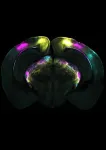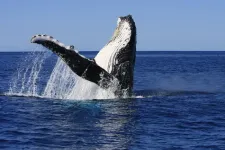(Press-News.org) Whale song can be as efficient as – and, in some cases, more efficient than – human communication, according to a new study in Science Advances. Meanwhile, new unrelated research in Science further investigates whale song’s adherence to a universal linguistic law, as observed in recordings of humpback whales.
Natural selection favors the pithy over the longwinded. For example, yelling “Duck!” is faster and far more effective than shouting “Be careful, there is an incoming projectile, and you need to move out of the way!” Two linguistic laws of abbreviation called Menzerath’s law and Zipf’s law calculate such efficiencies in vocalization. The former describes how efficiency increases when longer words or songs have shorter elements, such as syllables and notes. The latter says that efficiency increases when individual elements that are used more frequently are shorter. The independent work in Science Advances applies both Menzerath’s law and Zipf’s law to whale song, analyzing sequences from a total of 16 species of cetaceans, including dolphins and both toothed and baleen whales. Here, Mason Youngblood examined components within 65,511 whale song sequences and 51 human languages, defining efficiency by Menzerath’s law first. Vocalizations by 11 out of 16 species displayed Menzerath’s law at a degree equal to or greater than that seen in human speech. The exceptions were killer whales, Hector’s dolphins, Commerson’s dolphins, Heaviside’s dolphins, and North Pacific right whales. Youngblood then examined Zipf’s law. Only humpback and blue whales followed this law, and humpbacks alone followed the law to the extent seen in human speech.
In the unassociated study in Science, Inbal Arnon and colleagues applied quantitative methods typically used to evaluate infant speech and found that the culturally evolved learnability of human languages also applies to humpback whale song. In human language, structurally coherent units exhibit a frequency distribution that follows a power law, also known as a Zipfian distribution – an attribute that facilitates learning and likely enhances the accurate preservation of language across generations. Humpback whale song presents a compelling parallel to human language, as it is one of the most intricate vocal displays in the animal kingdom and is also passed down through cultural transmission. These songs are highly structured, consisting of nested hierarchical components – sound elements forming phrases, phrases repeating into themes, and themes combining into songs. If the statistical properties of human language arise from cultural transmission, similar patterns should be detectable in whale song. Arnon et al. used infant-inspired speech segmentation techniques to analyze 8 years of recorded humpback whale song data and discovered hidden structures within whale songs that exhibit striking parallels to human language. Specifically, these songs contain statistically coherent subsequences that conform to Zipfian distribution. Moreover, the lengths of these subsequences adhere to Zipf’s law of brevity, an efficiency-driven principle found in numerous species, including humans. This striking parallel between two evolutionarily distant species underscores the profound role of learning and cultural transmission in shaping communication across species, challenging the notion that such structural properties are exclusive to human language. “From what is known, humpback whale song and bird song exhibit patterns that follow these laws and principles without conveying the semantic meanings that human languages do. To this extent, we should perhaps be comparing whale songs to human music,” Andrew Whiten and Mason Youngblood write in a Perspective associated with the study in Science. “What these important parallels highlight is that communication systems in distantly related species may nevertheless converge toward similar structures, especially those that are complex, culturally learned, and effective.”
END
Whale song has remarkable similarities to human speech in terms of efficiency
Summary author: Abigail Eisenstadt & Walter Beckwith
2025-02-06
ELSE PRESS RELEASES FROM THIS DATE:
Uncovered: How mice override instinctive fear responses
2025-02-06
Researchers have uncovered a neural mechanism in the brains of mice that enables them to override instinctive fear responses; dysfunction in this mechanism may contribute to inappropriate or excessive fear responses, they say. According to the findings, targeting these circuits could offer new therapeutic avenues for treating fear-related disorders like post-traumatic stress disorder and anxiety. Fear responses to visual threats, such as escaping from an approaching predator, are critical instinctive reactions for survival and are ...
A pathway that contributes to insulin resistance can be targeted, mouse study shows
2025-02-06
The hormone adrenomedullin disrupts insulin signaling in blood vessel cells, contributing to systemic insulin resistance in obesity-associated type 2 diabetes, according to a new study. Blocking adrenomedullin’s effects restores insulin function and improves glucose control in a mouse model, suggesting a potential new target for treating obesity-related metabolic disease. Diabetes is a leading global cause of illness, mortality, and healthcare expenditures, with most cases stemming from obesity-induced insulin resistance and type 2 diabetes mellitus. Insulin resistance primarily ...
Special Issue: The cryosphere
2025-02-06
In this Special Issue of Science, 3 Reviews and a Policy Forum highlight research on Earth’s frozen places – from the Arctic to the Antarctic – and how it’s changing due to climate change and the geopolitical challenges this important work faces. In the first Review, Julienne Stroeve and colleagues provide a preview of what the Arctic region may look like in a warmer world. Without stronger climate action, global temperatures are set to rise +2.7°C above preindustrial levels, ...
Scientists discover brain mechanism that helps overcome fear
2025-02-06
Researchers at the Sainsbury Wellcome Centre (SWC) at UCL have unveiled the precise brain mechanisms that enable animals to overcome instinctive fears. Published today in Science, the study in mice could have implications for developing therapeutics for fear-related disorders such as phobias, anxiety and post-traumatic stress disorder (PTSD).
The research team, led by Dr Sara Mederos and Professor Sonja Hofer, mapped out how the brain learns to suppress responses to perceived threats that prove ...
Mantis shrimp clubs filter sound to mitigate damage
2025-02-06
Known for their powerful punch, mantis shrimp can smash a shell with the force of a .22 caliber bullet. Yet, amazingly, these tough critters remain intact despite the intense shockwaves created by their own strikes.
Northwestern University researchers have discovered how mantis shrimp remain impervious to their own punches. Their fists, or dactyl clubs, are covered in layered patterns, which selectively filter out sound. By blocking specific vibrations, the patterns act like a shield against self-generated shockwaves.
The study will be published on Friday (Feb. 7) in the journal Science.
The findings someday could be applied to developing ...
Large differences in water-seeking ability found in U.S. corn varieties
2025-02-06
A corn plant knows how to find water in soil with the very tips of its roots, but some varieties, including many used for breeding high-yielding corn in the U.S., appear to have lost a portion of that ability, according to a Stanford-led study. With climate change increasing droughts, the findings hold potential for developing more resilient varieties of corn.
The study, published in the journal Science, uncovers genetic mechanisms behind root “hydropatterning,” or how plant roots branch toward water and avoid dry spaces in soil. In particular, the researchers ...
Whale song has structure similar to human language
2025-02-06
Humpback whale song is a striking example of a complex, culturally transmitted behavior, but up to now, there was little evidence it has language-like structure. Human language, which is also culturally transmitted, has recurring parts whose frequency of use follows a particular pattern. In humans, these properties help learning and may come about because they help language be passed from one generation to the next. This work innovatively applies methods inspired by how babies discover words in speech to humpback whale recordings, uncovering the same statistical structures found in all human languages. It reveals previously undetected structure in ...
Cracking the Burmese python code: New data zeroes in on game-changing strategies
2025-02-06
In a groundbreaking study, University of Florida scientists statistically analyzed large amounts of data collected by Burmese python contractors, revealing critical insights about how to most efficiently remove the reptiles.
Researchers correlated survey outcomes, including python removals, with survey conditions, using statistical modeling. For example, the researchers examined if factors like time or temperature impacted the chance of removing a python. They also analyzed whether the most surveyed areas aligned with the highest python removals. This allowed the researchers to ...
Risk it or kick it? Study analyzes NFL coaches’ risk tolerance on fourth down
2025-02-06
During the Super Bowl, every decision matters. With millions of fans watching, the game often comes down to a single play call. And no call is more scrutinized than what a coach decides to do on fourth down. Punt? Attempt a field goal? Or go for it?
A new BYU study explains why NFL coaches, including Super Bowl contenders Andy Reid (Kansas City Chiefs) and Nick Sirianni (Philadelphia Eagles), may behave too conservatively on fourth down. Despite growing acceptance of analytics-driven decision-making, most coaches, ...
UC3M patents a new design for a soft robotic joint that is more adaptable and robust
2025-02-06
Researchers at Universidad Carlos III de Madrid (UC3M) have developed a new soft joint model for robots with an asymmetrical triangular structure and an extremely thin central column. This breakthrough, recently patented, allows for versatility of movement, adaptability and safety, and will have a major impact in the field of robotics.
“The main feature of this new design is that it allows greater bending angles to be achieved with less force, providing the robots with great versatility and adaptability of movement,” explains Concha Monje, professor in the UC3M Department ...
LAST 30 PRESS RELEASES:
Norbert Holtkamp appointed director of Fermi National Accelerator Laboratory
New agentic AI platform accelerates advanced optics design
Biologists discover neurons use physical signals — not electricity — to stabilize communication
Researchers discover that a hormone can access the brain by hitchhiking
University of Oklahoma researcher awarded funding to pursue AI-powered material design
Exploring how the visual system recovers following injury
Support for parents with infants at pediatric check-ups leads to better reading and math skills in elementary school
Kids’ behavioral health is a growing share of family health costs
Day & night: Cancer disrupts the brain’s natural rhythm
COVID-19 vaccination significantly reduces risk to pregnant women and baby
The role of vaccination in maternal and perinatal outcomes associated with COVID-19 in pregnancy
Mayo Clinic smartwatch system helps parents shorten and defuse children's severe tantrums early
Behavioral health spending spikes to 40% of all children’s health expenditures, nearly doubling in a decade
Digital cognitive behavioral treatment for generalized anxiety disorder
Expenditures for pediatric behavioral health care over time and estimated family financial burden
Air conditioning in nursing homes and mortality during extreme heat
The Alps to lose a record number of glaciers in the next decade
What makes a good proton conductor?
New science reporting guide published for journalists in Bulgaria
New international study reveals major survival gaps among children with cancer
New science reporting guide published for journalists in Turkey
Scientists develop a smarter mRNA therapy that knows which cells to target
Neuroanatomy-informed brain–machine hybrid intelligence for robust acoustic target detection
Eight SwRI hydrogen projects funded by ENERGYWERX
The Lundquist Institute and its start-up company Vitalex Biosciences Announces Strategic Advancement of Second-Generation fungal Vaccine VXV-01 through Phase 1 Trials under $40 Million Competitive Con
Fine particles in pollution are associated with early signs of autoimmune disease
Review article | Towards a Global Ground-Based Earth Observatory (GGBEO): Leveraging existing systems and networks
Penn and UMich create world’s smallest programmable, autonomous robots
Cleveland researchers launch first major study to address ‘hidden performance killer’ in athletes
To connect across politics, try saying what you oppose
[Press-News.org] Whale song has remarkable similarities to human speech in terms of efficiencySummary author: Abigail Eisenstadt & Walter Beckwith






